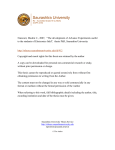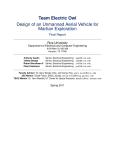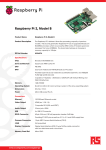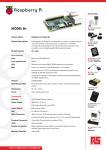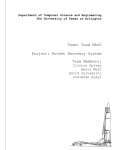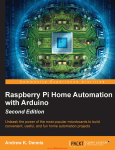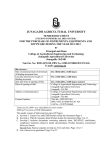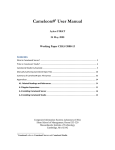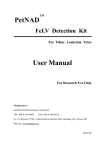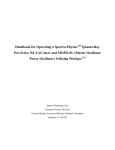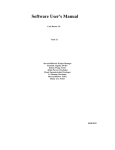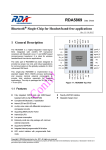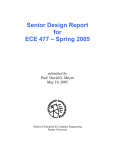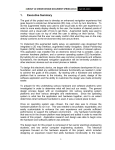Download View_pdf - International Journal of Computer Science and Mobile
Transcript
Mehta Karankumar D. et al, International Journal of Computer Science and Mobile Applications, Vol.2 Issue. 11, November- 2014, pg. 33-40 ISSN: 2321-8363 Analysis of TOI (Things of Internet) Industrial Monitoring System on Raspberry pi Platform 1 Mehta Karankumar D., 2Mehta Shreya B., 3Raviya Kapil S. 1 UG Student, Department of Electronics & Communication Engineering., C.U.Shah College of Engineering and Technology, Wadhwan, Gujarat, India, [email protected] 2 UG Student, Department of Electronics & Communication Engineering., C.U.Shah College of Engineering and Technology, Wadhwan, Gujarat, India, [email protected] 3 Assistant Professor, Department of Electronics & Communication Engineering, C.U.Shah College of Engineering and Technology, Wadhwan, Gujarat, India, [email protected] Abstract An embedded system is a computer system design for specific control function within a large system often with real time computing system. This research paper was developed to produce web based temperature, humidity & pressure monitoring system that allows to continue monitor these parameters. This system allowed the data to be anytime & anywhere from the internet after we login into webpage. This research paper also concludes that user can set limit range of the above parameters & if these parameters goes beyond that value, it will turn off devices. With Ethernet-based, internet-enabled instrumentation, remote access can be anywhere a smartphone has a signal. From the simplest application, viewing data through the web-browser on your iPhone, Blackberry device or laptop, to more sophisticated uses, such as sending a text or e-mail message when an alarm occurs, or transmitting a data log file over the internet from a remote location to a central office. Keywords: Raspberry pi, Raspibian, Ethernet, Sensors 1. Introduction Monitoring is employed in various applications, including temperature, pressure, flow rate, capacity, acceleration, and so on. According to the quantities, distribution and detected frequency o f the monitored objects, there are different monitoring methods to acquire the measurements. Several problems usually occur during the monitoring process of the temperature in a room. For example, a server room must be kept between 15 to 20 degree Celsius to monitor a temperature in or else the server might crash and can cause a loss of hundreds thousands. Management has to choose either to place a person to monitor the temperature, or to save on human capital by developing a system that can monitor the temperature from other places at any given time. In order to solve the problem, the web-based temperature, humidity & pressure monitoring system that can be access anywhere and anytime through the Internet is build. With this system a user can remotely monitor the room temperature, humidity & pressure from anywhere which could save the human expenses. Web-Based Temperature, humidity & pressure Monitoring is one type of recorder that monitors this parameters in a room and stores the data into a database and display the current status on the website through a web server. The system will continuously monitor the temperature condition of the room and the data can be monitored at anytime and anywhere from the Internet. This monitoring is widely used in various processes like in automotive industries, air conditioning, power plant and other industries that need the data to be saved and analysed. Proposed design is to have the data acquisition system to measure and log some parameters. The main purpose of this system model is to make it easy for the user to view the current temperature, humidity & pressure. The paper includes complete implementation of an HTTP Web Server in Raspberry Pi. This development kit which contains Ethernet interface is connected to PC using RJ45 cable. Sensors are connected to raspberry pi by I2C integrated circuit. ARM web server based raspberry pi has fast execution capability & Ethernet standard can provide internet access with reasonable speed. It is suitable for enhancing security in ©2014, IJCSMA All Rights Reserved, www.ijcsma.com 33 Mehta Karankumar D. et al, International Journal of Computer Science and Mobile Applications, Vol.2 Issue. 11, November- 2014, pg. 33-40 ISSN: 2321-8363 industrial condition by remotely monitoring various industrial application. For security purpose login are provided for employer who will monitor the plant when client type IP add on web browser & logged in he/she will get webpage that contain parameters. 2. SYSTEM DESIGN The d esigning p ar t includ es b a sic al l y two sections as follows. 2.1 Hardware design 2.2 Software design 2.1. Hardware Design It includes Raspberry Pi B+ model, Temperature sensor, humidity sensor & pressure sensor, I2C(Inter Integrated Circuit). 2.1.1. Raspberry Pi The Raspberry Pi is a credit-card-sized single-board computer developed in the UK by the Raspberry Pi Foundation. It has a Broadcom BCM2835 system on a chip (SoC), which includes an ARM1176JZF-S 700 MHz processor, Video Core IV GPU. Its GPU provides Open GL ES 2.0, hardware-accelerated Open VG, and 1080p30 H.264 high- profile decode which is capable of 1Gpixel/s, 1.5Gtexel/s or 24GFLOPs with texture filtering with 512 MB RAM. It does not include a built-in hard disk or solid-state drive, but uses an SD card for booting and persistent storage. It has 10/100 Base T Ethernet socket. The Raspberry Foundation provides Debian and Arch Linux ARM distributions for download. Tools are available for Python as the main programming language, with support for BBC BASIC(via the RISC OS image or the Brandy Basic clone for Linux), C, C++, Java, Perl and Ruby. The video controller is capable of standard modern TV resolutions, such as HD and Full HD, and higher or lower monitor resolutions and older standard CRT TV resolutions. Below figure shows advance specification of RASPBERRY PI. SoC: Broadcom BCM2835 (CPU, GPU, DSP, SDRAM, and USB ports) CPU: 700 MHz ARM1176JZF-S core (ARM11 family) GPU: Broadcom Video Core IV, OpenGL ES 2.0, MPEG-2 and VC-1 (with license), 1080p30 h.264/MPEG-4 AVC high-profile decoder and encoder Memory (SDRAM): 512 MB (shared with GPU) USB 2.0 ports: 4 (via integrated USB hub) Video outputs: Composite RCA (PAL and NTSC), HDMI (rev 1.3 & 1.4), raw LCD Panels via DSI,14 HDMI resolutions from 640×350 to 1920×1200 plus various PAL and NTSC standards. Audio outputs: 3.5 mm jack, HDMI On-board storage: SD / MMC / SDIO card slot On-board network: 10/100 Ethernet (RJ45) via USB hub ©2014, IJCSMA All Rights Reserved, www.ijcsma.com 34 Mehta Karankumar D. et al, International Journal of Computer Science and Mobile Applications, Vol.2 Issue. 11, November- 2014, pg. 33-40 ISSN: 2321-8363 Low-level peripherals: 8 × GPIO, UART, I²C bus, SPI bus with two chip selects, +3.3 V, +5 V, ground Power ratings: 700 mA (3.5 W) Power source: 5 volt via Micro USB or GPIO header Size: 85.60 mm × 53.98 mm (3.370 in × 2.125 in) Weight: 45 g (1.6 oz) Operating systems: Debian GNU/Linux, Fedora, Arch Linux ARM, RISC OS Table 1. Features of raspberry Pi Applications of Raspberry pi 1. Cyber Based Home Automation :- Cyber Automation refers to „Automation on Internet‟. It uses the concept of „Internet of Things‟ for automating the home equipment. This means that a user of this automation system can exclusively control the home equipment from anywhere in the world provided an internet connection. 2. E-Book Reader :- Any device that can display text on a screen may act as an e-book reader, but specialized e-book reader designs may optimize portability, readability (especially in bright sun) and battery life for this purpose. A single e-book holds the equivalent of many printed texts with no added mass or bulk. 3. Internet radio :- Internet radios still cost a pretty penny, so why not pair up the Pi with a low-cost LCD screen, some speakers and create your own. Various Pi-based internet radio projects already exist and are piecing together the components and code needed to create a Pi-based internet radio, and it seems only a matter of time before this becomes a reality. 2.1.2. Temperature Sensor – DS8B20 The DS18B20 digital thermometer provides 9-bit to 12-bit Celsius temperature measurements and has a n a l a r m f u n c t i o n with nonvolatile u s e r - programmable upper and lower trigger points. The DS18B20 communicates over a 1-Wire bus that by definition requires only one data line (and ground) for communication with central microprocessor. It is operating temperature range of -55°C to +125°C and is accurate to ±0.5°Cover the range of -10°C to +85°C. In addition, the DS18B20 can derive power directly from the data line (“parasite power”), eliminating the need for an external power supply. 2.1.3 Humidity Sensor-DHT22 AM2302 output calibrated digital signal. It applies exclusive digital-signal-collecting-technique and humidity sensing technology, assuring its reliability and stability. Its sensing elements are connected with 8-bit singlechip computer. Every sensor of this model is temperature compensated and calibrated in accurate calibration chamber and the calibration-coefficient is saved in type of program in OTP memory, when the sensor is detecting, it will cite coefficient from memory. Small size & low consumption & long transmission distance (100m) enable AM2302 to be suited in all kinds of harsh application occasions. Single-row packaged with four pins, making the connection very convenient. ©2014, IJCSMA All Rights Reserved, www.ijcsma.com 35 Mehta Karankumar D. et al, International Journal of Computer Science and Mobile Applications, Vol.2 Issue. 11, November- 2014, pg. 33-40 ISSN: 2321-8363 2.1.4 Pressure Sensor-BMP-085 This is breakout board for the BMP085 from is a high-precision, low-power barometric pressure sensor. The BMP085 offers a measuring range of 30 to 110 kPa with an absolute accuracy of down to 0.1 kPa. It uses piezo-resistive technology for robustness, accuracy and linearity as well as long term stability. This sensor supports a voltage supply between 1.8 and 3.6VDC. It is designed to be connected directly to a microcontroller via an I2C bus. The breakout board‟s pins are spaced 0.1" apart making it easy to use with standard breadboards and 0.1" perfboards. The analog and digital supplies (VDDD and VDDA) of the BMP085 are tied together and broken out to a single pin. The I²C lines are pulled high with 4.7kΩ resistors. 2.1.5 I2C (Inter Integrated Circuit) I2C (Inter-Integrated Circuit, pronounced "I squared C") is also a synchronous protocol, and it's the first we see which has some "intelligence" in it; the other ones dumbly shifted bits in and out, and that was that. I2C uses only 2 wires, one for the clock (SCL) and one for the data (SDA). That means that master and slave send data over the same wire, again controlled by the master who creates the clock signal. I2C doesn't use separate Slave Selects to select a particular device, but has addressing. The first byte sent by the master holds a 7 bit address (so that you can use 127 devices on the bus) and a read/write bit, indicating whether the next byte(s) will also come from the master of should come from the slave. After each byte receiver must send a "0" to acknowledge the reception of the byte, which the master latches with a 9th clock pulse. If the master wants to write a byte the same process repeats: the master puts bit after bit on the bus and each time gives a clock pulse to signal that the data is ready to be read. If the master wants to receive data it only generates the clock pulses. The slave has to take care that the next bit is ready when the clock pulse is given. 2.2 Software Design It includes Raspbian OS and Python language. 2.2.1 Raspbian OS Raspbian is an unofficial port of Debian Wheezy arm hf with compilation settings adjusted to produce code that uses "hardware floating point", the "hard float" ABI and will run on the Raspberry Pi. The port is necessary because the official Debian Wheezy arm hf release is compatible only with versions of the ARM architecture later than the one used on the Raspberry Pi. 2.2.2 Python Language Python is a widely used general-purpose, language. Its design philosophy emphasizes code readability, and its syntax allows programmers to express concepts in fewer lines of code than would be possible in languages such as C++ or Java. The language provides constructs intended to enable clear programs on both a small and large scale. Python supports multiple programming paradigms including object-oriented imperative and functional programming and procedural styles. It features a dynamic type system and automatic memory management and has large and comprehensive standard library. ©2014, IJCSMA All Rights Reserved, www.ijcsma.com 36 Mehta Karankumar D. et al, International Journal of Computer Science and Mobile Applications, Vol.2 Issue. 11, November- 2014, pg. 33-40 ISSN: 2321-8363 Fg.1 Raspberry pi B+ model 3. PROPOSED SYSTEM As shown in fig.2 there are two premises, one is plant premise and another is office premise. In plant premise all hardware set up is installed. There are various sensors like temperature, humidity, a pressure sensor which senses the environment and send signal to raspberry pi. Raspberry pi has inbuilt ARM processor which process the data and send it to internet through LAN/ETHERNET connection. On office premise user can log into account and can check all parameters within single window by GUI and database system. User can also set limit range of parameter and if parameter goes beyond that value then it will give control signal to hardware in plant and it will turn on/off device according to that. This way we can make whole plant atomize to make all system work well and within specified parameters.There are some applications like industrial plant, hospital, warehouse environment surveillance, weather monitoring, medicine storage etc. ©2014, IJCSMA All Rights Reserved, www.ijcsma.com 37 Mehta Karankumar D. et al, International Journal of Computer Science and Mobile Applications, Vol.2 Issue. 11, November- 2014, pg. 33-40 ISSN: 2321-8363 Fig.2 Block Diagram of Industrial Plant Monitoring System 4. REALTED WORK Automated Temperature Tracking system has been implemented in Clueless Hospital, USA. It operates seven Operation Theatres, Intensive Critical Care Unit (ICCU), and Neonatal Intensive Care Unit (NICU), which are regularly monitored for ensuring optimum ambient temperature. Maintaining them manually is labour intensive and error detection process for maintenance. The project aims to automate the monitoring of temperature in critical locations throughout Clueless Hospital. The data will be accessible from a central server using any web browser connected to the Local Area Network (LAN). The project has provided custom software to simultaneously monitor room temperature in several locations throughout the hospital using iButton temperature sensors and Tiny Internet Interface (TINI) networked microcontrollers. Speech Synthesized Temperature Sensor is the device that informs the user via a verbal message of the current environmental temperature. The project is versatility I n applications. The device could be used as an extra layer of security in the car safety seat project. Given a user defined temperature threshold, the device will issue a warning to the driver to remove the child from the car. The warning message can be programmed to execute repeatedly to really get the drivers attention. Also, the device could be used as an aid to the visually impaired. The user can find out many physical aspects of their environment simply by hitting a switch. Some environmental aspects may include temperature, gas leaks, humidity, and etc. The purpose of the project is it will focus on interfacing a speech synthesizer with a temperature sensor. 5. CONCLUSION AND FUTURE EXPANSION Implantation of this project using Raspberry Pi for intelligent monitoring is a new method to monitor an environment of industrial plant which designed here for the real time implementation. It supports onlinesupervision and control not only within Private Network (LAN) but also in Public Network (Internet).The whole system has low-cost, good openness and portability, and is easy to maintain and upgrade. It is possible to interface different kind of Sensors with these modules and make various applications. So it can monitor embedded system operation state through Internet, achieving network monitoring purposes. ©2014, IJCSMA All Rights Reserved, www.ijcsma.com 38 Mehta Karankumar D. et al, International Journal of Computer Science and Mobile Applications, Vol.2 Issue. 11, November- 2014, pg. 33-40 ISSN: 2321-8363 This work can further be extended with usage of this system along with wireless sensor networks with increase in parameters and increase in sensor nodes. ACKNOWLEDGEMENT We would like to express our sincere gratitude to our mentor Mr.Kapil S Raviya, Assistant Professor in Electronics and Communication Engineering Department, C.U.Shah College of Engineering & Technology for his guidance, encouragement and valuable suggestion. We express our heartfelt thanks to our family members and all our friends who helped us to complete this review paper and finally, We thank the exciting super natural power, the almighty for being with us all through our life. REFERENCES 1. 2. 3. 4. 5. 6. 7. 8. 9. 10. M.Kasin, M.N.Ismil & C.K.H.Che Ku Yahaya,March-2011 ”Web Based Temperature Monitoring System” in International journal of Multidisciplinary Sciences & Engineering Vol No.1, No.2. Bhuvaneswari.S, Sahaya Anselin Nisha,,March-2014 “Implemented of TCP/IP On Embedded webserver using Raspberry Pi in Industrial Application” in International Journal of Advanced Research in Computer & Communication Engineering vol.3,issue3. S.L.Y. Youling, X. Weisheng, 2007, “Design of Remote Real- Time Temperature Monitoring System”. The Eighth International Conference on Electronic Measurement and Instruments ICEMI Proceeding. Jichang-peng, Zhan mei-qiong, 2008, International Conference on MultiMediaand Information Technology, Research and Implementation of Embedded Web Server. Nakul Padhye, Preet Jain, April 2013, Implementation of Arm Embedded Web Server for DAS using Raspberry pi, Vol.3 No.4. S.Hongyao, F.Jianzhong, C.Zichen, Nov.2006, “Embedded system of temperature testing based on DS18B20”, International Technology and Innovation Conference 2006, p.4. I2C bus specification & user manual Rev,vol.3,p.19, national semiconductor-2007. L.Breniuc, C.G.Haba, 1-15 June 2002, “Web-Based Monitoring and Control of a Temperature Measurement System”. Proceedings of the 2nd on- line Workshop on Tools for Education in Measurement, Tampere, Finland, pp. 11- 15. C.G. Haba, L. Breniuc, and V. David, 2008, “E-Learning System for Temperature and Humidity Sensors and Distributed Measurement”. Faculty of Electrical Engineering. Adajania, V.,Agarwal, M Dandekar, S.andKaria, D.C., July 2011 “Embedded Web Server Application Based Automation and Monitoring System,” International Conference on Signal Processing, Communication, Computing and Networking Technologies, pp.634-637. URL 1. 2. Raspberry Pi Fourm and Discussion Page http://www.raspberry.org. http://www.sparkfun.com/datasheets/Components/General/BST-BMP085-DS000-05.pdf. AUTHORS 1 Mehta Karankumar D. has completed his Diploma Engineering in Electronics & Communication from Nirma University-2012, Ahmedabad, Gujarat, India. He is currently pursuing Bachelor of Engineering in Electronics & communication at C.U.Shah college of Engineering & Technology, Wadhwan, Gujarat, India. His area of research in Digital Electronics, Embedded Systems & Microcontrollers. ©2014, IJCSMA All Rights Reserved, www.ijcsma.com 39 Mehta Karankumar D. et al, International Journal of Computer Science and Mobile Applications, Vol.2 Issue. 11, November- 2014, pg. 33-40 ISSN: 2321-8363 2 Mehta Shreya B. has completed his Diploma Engineering in Electronics & Communication from Gujarat Technology University-2012, Ahmedabad, Gujarat, India. She is currently pursuing Bachelor of Engineering in Electronics & communication at C.U.Shah college of Engineering & Technology, Wadhwan, Gujarat, India. Her area of interest in Communication Engineering & Electronics Technologies. 3 Raviya Kapil S. has completed his bachelor and master‟s degree in the Electronics & Communication Engineering from Saurashtra University and Gujarat Technological University Gujarat, India and he is currently pursuing his Ph.D. in the same discipline from C.U Shah University, wadhwan, Gujarat. His Area of research is image processing and computer vision system. He is currently working as an assistant professor in the department of Electronics & Communication engineering at C.U Shah College of engineering and technology. ©2014, IJCSMA All Rights Reserved, www.ijcsma.com 40









